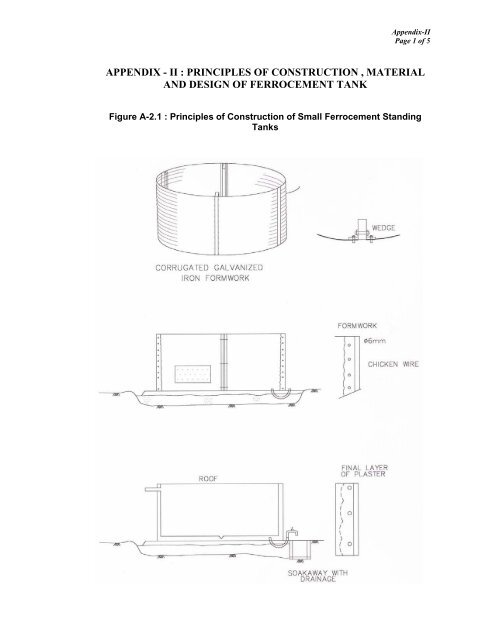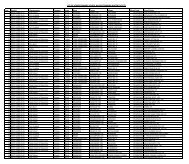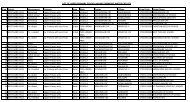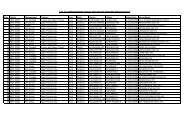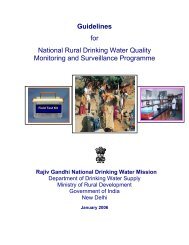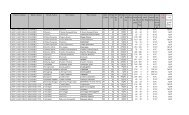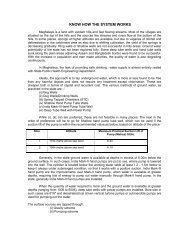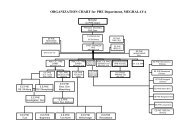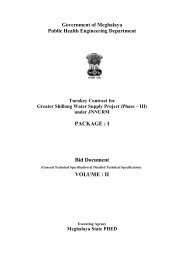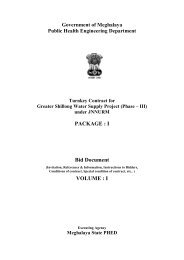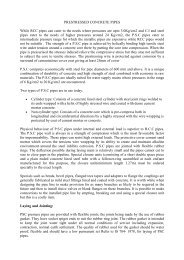APPENDIX - II : PRINCIPLES OF CONSTRUCTION , MATERIAL ...
APPENDIX - II : PRINCIPLES OF CONSTRUCTION , MATERIAL ...
APPENDIX - II : PRINCIPLES OF CONSTRUCTION , MATERIAL ...
You also want an ePaper? Increase the reach of your titles
YUMPU automatically turns print PDFs into web optimized ePapers that Google loves.
Appendix-<strong>II</strong><br />
Page 1 of 5<br />
<strong>APPENDIX</strong> - <strong>II</strong> : <strong>PRINCIPLES</strong> <strong>OF</strong> <strong>CONSTRUCTION</strong> , <strong>MATERIAL</strong><br />
AND DESIGN <strong>OF</strong> FERROCEMENT TANK<br />
Figure A-2.1 : Principles of Construction of Small Ferrocement Standing<br />
Tanks
<strong>MATERIAL</strong>S NEEDED FOR FERROCEMENT TANK <strong>CONSTRUCTION</strong><br />
Cement<br />
Appendix-<strong>II</strong><br />
Page 2 of 5<br />
Three types of cement are available in the Indian Market and all the three can be used for<br />
ferrocement tank construction:<br />
1. Ordinary Portland Cement (O.P.C.) may be used in normal conditions.<br />
2. Portland Puzolona Cement (P.P.C.) may be used in normal conditions but after<br />
checking the mortar setting.<br />
3. High-early-strength Cement (quick setting cement) may be used in cold climatic<br />
zones and also in places where early setting and strength gaining is desired.<br />
Sand<br />
Sand from local sources may be checked/ tested and depending upon its properties, can be<br />
selected to meet the requirement in terms of silt contents, freedom from chemical pollution<br />
and trading. Medium coarse sand with grading may be used for ferrocement jobs.<br />
In order to find strength of mortar for designing, the tank mortar specimens may be made<br />
from these local sands. The ratio of cement : sand is 1:2 to 1:3 by volume, and water : cement<br />
ratio is 1:3 0.45 by weight (Recommended WC is 0.4) but 0.45 may be used to allow for the<br />
variation in the degree of control in the field. The desirable strengths of the mortar are as<br />
follows :<br />
Wire Mesh<br />
Tensile strength at 28 days : 17-30 kg/cm 2<br />
(direct tension test ASTM, C190)<br />
Compressive strength at 28 days : 200 kg/cm 2<br />
(2” cube)<br />
The most common wire meshes used for ferrocement are hexagonal wire mesh, square<br />
welded mesh and woven square mesh. Use of woven square mesh is preferred for F.C. Water<br />
Tanks.<br />
Chemical Admixtures<br />
Selected grade of poresealing compound and plasticizer may be added to the mortar to be<br />
used for construction of F.C. Tanks.<br />
Table A-2.1 : Description and Properties of Hexagonal & Square Woven Wire<br />
Meshes<br />
Ultimate Strength 8740 kg/cm 2<br />
Yield Strength 2100 kg/cm 2<br />
Modulus of elasticity 93.75 x 10 4 kg/cm 2
Appendix-<strong>II</strong><br />
Page 3 of 5<br />
Mesh mm Size (inch) Wire diameter commonly Roll size generally<br />
available (mm)<br />
available<br />
19 (3/4) 0.5 to 1.2 0.91 to 1.2m x 45.7 m<br />
(3 to 4 x 150) for<br />
hexagonal mesh<br />
10 (3/8) 0.5 to 1.2 0.75 to 1.5m x 15 to<br />
30 m (2.5 x 100) for<br />
square woven mesh<br />
12.5 (1/2) 0.5 to 1.2 -<br />
For water tank construction without the aid of a formwork, the tank reinforcement must be<br />
strong enough to hold the weight of mortar applied on it and must also be stiff enough to<br />
prevent slumping of motor during plastering. Hence the square woven mesh of grid size 12.5<br />
mm (0.91 × 30.5 m roll size) has been chosen because to its stiffness when compared to<br />
hexagonal mesh and cost advantage when compared to welded wire meshes.<br />
Tank Dimensions 12m 3 Unit 15m 3 Unit<br />
Diameter 2.5 m 2.5m<br />
Area (in plan) of tank 4.90 m 2 4.90 m 2<br />
Height 2.50 m 3.11 m<br />
Wall Thickness 30 mm 30 mm<br />
Actual Volume of 12.27 m 3 15.19 m 3<br />
container<br />
Capacity for water<br />
storage<br />
12 m 3 15 m 3<br />
The maximum hoop stresses obtained from an analysis of fixes and hinged types connections<br />
between the wall and the base are 6.64 kg/cm 2 and 7.18 kg/cm 2 respectively. The maximum<br />
bending moment at the base of the wall is 34.20 kg-cm/cm width, which creates a maximum<br />
fibre stress of 12.83 kg/cm 2 , if the wall is not reinforced.<br />
DESIGN<br />
The stresses occurring in the tank are small and do not exceed event the tensile strength of<br />
unreinforced mortar (17 kg/cm 2 ) hence, in this case, the design of the tank is controlled partly<br />
by construction techniques and the sizes of materials available. For ease in construction, the<br />
tank reinforcement chosen of 6 mm skeletal steel rods sandwiched between two layers of<br />
12.5 mm squares, woven 20g (0.9 mm) wire G.I. mesh should be used. The distance between<br />
the mesh layers should be 13 to 15 mm.<br />
A single tank can be constructed in four days. Construction can be carried out by unskilled<br />
labour if good finishing, plastering is not required. Water tightness of the tank is excellent. A<br />
waterline or a seepage loss, which is normally visible in a concrete tank when it is first filled<br />
with water, does not exist. Villagers may at first be sceptical because of the thickness of the<br />
walls of the tank but these reactions, however, will change when the tank shows its<br />
remarkable strength.
Casting of Roof for Tanks<br />
Appendix-<strong>II</strong><br />
Page 4 of 5<br />
Ferrocement roofs for water tanks are also precast over masonry moulds in one piece or in 4<br />
to 6 pieces depending upon size and height of the tank. Jointing method for roof segments is<br />
the same as for wall segment. If the roof is in pieces, the pieces are erected, placed in position<br />
at the top and supported temporarily. The laps of reinforcement for joints are fixed up and the<br />
joints are filled with mortar. Two types of joints between wall and roof can be adopted.<br />
1. The edge cast around the roof is placed in collar provided at the top of the wall<br />
(assembled with segments) and the mortar is filled in the wall roof paint.<br />
2. The roof/ roof segment edge beam covers the wall top edge, like a cover<br />
Various stages of construction of Roofing Units for Ferrocement tanks have been shown in<br />
Figure A-2.2.<br />
Do’s and Don’ts for Ferrocement Tanks<br />
Do’s<br />
1. Use the best quality material for constructing the tank.<br />
2. Take all care to see that there are no lose pockets or honey-combed areas in the<br />
surface of wall or base of ferrocement tank. If such a defect is detected, repair it by<br />
chipping mortar on inside and outside surfaces (exposing the wire mesh in that area)<br />
and replastering.<br />
3. Cure F.C. tanks for a minimum of 10 days.<br />
4. Clean the tank from inside atleast twice a year.<br />
5. Keep the top of the tank clean to avoid entry of waste material in the tank.<br />
6. Construct the tank at higher point so that drainage of water is proper or construct a<br />
soaking pit and connect it to the tank by a drain.<br />
7. Take all care during mortar application and ensure that the mortar enters behind the<br />
seat rods and wires provided as skeletal steel and into the wire mesh layer<br />
reinforcement. Ensure that the cover over outer and inner mesh layer is not less than 3<br />
mm.<br />
Don’ts<br />
1. Do not allow animals to come near the tank.<br />
2. Do not allow children to climb over the tank.<br />
3. Do not use corrected steel or mesh for construction of the tank.<br />
4. Do not use old stocks of cement for tank construction.<br />
5. Sand to be used should be graded and clean sand having silt contents within 3 percent<br />
of the volume. Extra fine or coarse sand must not be used.<br />
6. Do not allow water fittings fixed in the tank to leak, it will not only waste water but<br />
may also prove a base for algae growth on fitting joints or surface of the tank and lead<br />
to development of bacteria colonies in these.<br />
7. Do not use chemically polluted water on mixing the mortar or curing of ferrocement<br />
tank.<br />
8. Do not paint drinking water tank without confirmation of specifications laid down by<br />
the Indian Standard Specifications 158 (I.S.–158).
Appendix-<strong>II</strong><br />
Page 5 of 5<br />
Figure A-2.2 : Mould and Reinforcement Cage for Roof of Ferrocement Water<br />
Tanks<br />
Reinforcement Cage for 60, 65,<br />
75 & 90 cm Diameter F.C. Tanks<br />
- Reinforcement Cage for Roof of F.C. Tanks<br />
of 120, 130, 140 & 160 cm Diameter<br />
- Wire Mesh Reinforcement 1 Layer of<br />
22G×½”×½” G.I. Woven Mesh on inside<br />
& outside surfaces<br />
Dia of Tank<br />
(cm)<br />
Rise in Roof Dome,<br />
(cm)<br />
Rise of Roof Dome<br />
65 75/80 90 120 160 200 300<br />
10 10 10 12 18 20 25<br />
- Reinforcement Cage for Roof of F.C. Tanks<br />
of Diameters upto 2.25 m<br />
- Wire Mesh 2-22G×½”×½” G.I. Woven Mesh<br />
one on each side<br />
Casting Matrix - Cement - 1 Part<br />
Medium Coarse Graded Sand - 2 Part<br />
Water - 0.4 Parts<br />
Poresealing Compound - 0.5 Percent of Cement<br />
Plasticizer - 0.5 Percent of Cement


